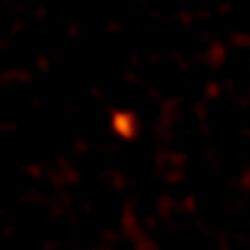Astronomy:2014 UZ224
 2014 UZ224 imaged by ALMA | |
| Discovery[1] | |
|---|---|
| Discovered by | David Gerdes et al. |
| Discovery site | Cerro Tololo Obs. |
| Discovery date | 19 August 2014 |
| Designations | |
| 2014 UZ224 | |
| DeeDee (nickname) | |
| Minor planet category | TNO[2] · SDO[3] p-DP[4] |
| Orbital characteristics[2] | |
| Epoch 31 May 2020 (JD 2459000.5) | |
| Uncertainty parameter 5 · 6[5] | |
| Observation arc | 12.08 yr (4,414 days) |
| Earliest precovery date | 15 October 2006[5] |
| |{{{apsis}}}|helion}} | 176.988±0.453 AU |
| |{{{apsis}}}|helion}} | 38.295±0.029 AU |
| 107.642±0.275 AU | |
| Eccentricity | 0.64423 |
| Orbital period | 1116.81±4.28 yr (407,913 days) |
| Mean anomaly | 320.482±0.210° |
| Mean motion | 0° 0m 3.177s / day |
| Inclination | 26.790° |
| Longitude of ascending node | 130.699±0.004° |
| |{{{apsis}}}|helion}} | ≈ 27 May 2142[6] ±67 days |
| 29.989±0.063° | |
| Physical characteristics | |
| Mean diameter | 635+65 −72 km[3] |
| Geometric albedo | 0.131+0.038 −0.028[3] |
| G–R = 0.77±0.11[3] | |
| Apparent magnitude | 23.38±0.05[3] |
| Absolute magnitude (H) | 3.5[3] · 3.4[2] |
2014 UZ224 is a trans-Neptunian object and possible dwarf planet orbiting in the scattered disc of the outermost Solar System. (As of 2021), it is approximately 89.7 astronomical unit|AU (13.42 billion km) from the Sun, and will slowly decrease in distance until it reaches its perihelion of 38 AU in 2142. The discoverers have nicknamed it "DeeDee" for "Distant Dwarf".[7][8]
2014 UZ224 was discovered by a team led by David Gerdes using data collected by the large camera Dark Energy Camera (DECam).[9][10] It has a diameter of ~635 km (395 mi) and reflects just 13 percent of the sunlight that hits it.[3][2] Since the numbering of (532037) 2013 FY27 in May 2019, 2014 UZ224 may be the largest unnumbered object in the Solar System (though see 2012 VP113).[4] The earliest known precovery observations of 2014 UZ224 were taken at the Mauna Kea Observatory on 15 October 2006.[5]
Orbit
It orbits the Sun once every approximately 1,100 years and is the second farthest object from the Sun with a stable orbit. Its perihelion is almost as close as Pluto’s aphelion and will reach it on the 22nd of May in 2142.
Numbering and naming
As of 2024, this minor planet has neither been numbered nor named by the Minor Planet Center.
See also
- List of Solar System objects most distant from the Sun
- List of Solar System objects by greatest aphelion
References
- ↑ "MPEC MPEC 2016-T104 : 2014 UZ224". IAU Minor Planet Center. 2016-10-11. http://www.minorplanetcenter.net/mpec/K16/K16TA4.html. Retrieved 2016-10-11. (K14UM4Z)
- ↑ 2.0 2.1 2.2 2.3 "JPL Small-Body Database Browser: (2014 UZ224)". Jet Propulsion Laboratory. http://ssd.jpl.nasa.gov/sbdb.cgi?sstr=2014UZ224. Retrieved 11 October 2016.
- ↑ 3.0 3.1 3.2 3.3 3.4 3.5 3.6 Gerdes, D. W.Expression error: Unrecognized word "etal". (April 2017). "Discovery and Physical Characterization of a Large Scattered Disk Object at 92 AU". The Astrophysical Journal Letters 839 (1): 7. doi:10.3847/2041-8213/aa64d8. Bibcode: 2017ApJ...839L..15G.
- ↑ 4.0 4.1 Brown, M. (20 May 2019), How many dwarf planets are there in the outer solar system?, http://web.gps.caltech.edu/~mbrown/dps.html, retrieved 1 June 2019
- ↑ 5.0 5.1 5.2 "2014 UZ224". International Astronomical Union. http://www.minorplanetcenter.net/db_search/show_object?object_id=2014+UZ224.
- ↑ JPL Horizons Observer Location: @sun (Perihelion occurs when deldot changes from negative to positive. Uncertainty in time of perihelion is 3-sigma.)
- ↑ "Soon you won't care about a newly discovered dwarf planet". Wired. 18 October 2016. https://www.wired.com/2016/10/dwarf-planets-arent-big-news-astronomy-great-job.
- ↑ "New dwarf planet solar system's 2nd most distant". Umich.edu.
- ↑ Cofield, Calla. "New Dwarf Planet Found in Our Solar System". Scientific American. https://www.scientificamerican.com/article/new-dwarf-planet-found-in-our-solar-system/?WT.mc_id=SA_FB_SPC_NEWS.
- ↑ "A Friend for Pluto: Astronomers Find New Dwarf Planet in Our Solar System". https://www.npr.org/sections/thetwo-way/2016/10/11/497071139/a-friend-for-pluto-astronomers-find-new-dwarf-planet-in-our-solar-system.
External links
- 2014 UZ224 ("DeeDee") Fact Sheet
- 2014 UZ224 at AstDyS-2, Asteroids—Dynamic Site
- 2014 UZ224 at the JPL Small-Body Database
 |


